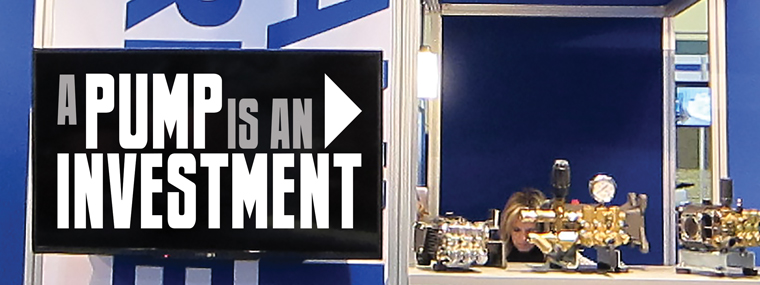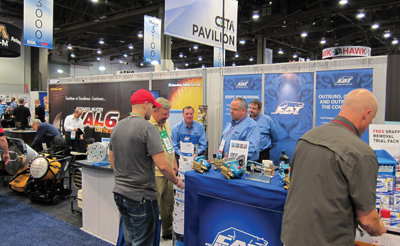
A Pump Is An Investment
By Diane M. Calabrese / Published May 2017

Pumps
The word “pump” may not capture the sound of the device in 2017, but the root word “pompe” in Middle English probably came close. After all, using the force of compression or suction (lift) to work against the considerable force of atmospheric pressure partnered with gravity can create some noise.
The sound of a pump reminds us of the considerable work being done. From the natural lub-dub sound of the heart to the bump-bump (pump-pump to some ears) of an engine room, pumps——displacement, centrifugal, and variants—play a commanding role in the world.
Pumped storage hydropower (PSH) facilities account for about 97 percent of the electricity stored by utilities across the United States. Excess energy is used to power the pumps that move water to higher elevation reservoirs. When there is great demand for electricity, water can be released to turn turbines and generate electricity.
The U.S. Department of Energy sees increasingly expanded roles for PSH. For example, PSH offers a way to integrate electricity from wind turbines and solar panels to the grid without battery storage. And PSH has the potential to be quickly scaled to much greater use because so much storage capacity already exists: only three percent of the nation’s dams generate electricity.
The quality of life and pumps are inextricably linked in the 21st century, but the tie is likely to become even tighter. For instance, pumps keep water moving through conduits when gravity does not. Keeping pressure from building here or there across a labyrinthine system is not an easy task. Pressure-releasing valves are one solution.
Any mechanism for releasing pressure (and protecting the pipeline integrity) also dissipates energy. So why not capture the energy and use it to generate electricity? The electricity could be returned to the grid or used to immediately power other functions, including pump action, along the pipeline. Projects to develop and expand this sort of energy-conserving approach are going on in states from Massachusetts to California. Expect to see more ‘harvesting’ of dissipated energy. Capturing and using dissipated energy is the ultimate form of conservation.
As pumps have become more efficient, energy has been conserved. Could some of the energy still being dissipated—via heat, especially—be captured for reuse? Heat, of course, is one highly disorganized form of energy and difficult to repurpose. Yet nothing should be ruled out as ingenuity takes pumps and their related entities to new levels. Particularly when pressure washers are part of larger systems such as in-line or cabinets or linked to wastewater capture, the possibilities for harvesting energy that would otherwise have to be regenerated is exciting and ultimately doable.
As fascinating as pumps are, they do not get the attention they deserve. On that we can agree. We should also agree that as a vital component of a pressure washer, a pump commands respect, attention, and understanding. To advance those ends, we put a few questions to three experts on pumps: Al Stasny, technical manager of A.R. North America Inc. in Fridley, MN; Mike Hansen, sales manager–water division with Dultmeier Sales in Omaha, NE; and Jim Drennen, mar-
keting manager at CAT Pumps in Minneapolis, MN.
Q&A Pumps
Cleaner Times [CT]: Is there one thing that must be done to properly maintain a pump?
Stasny: Set up a maintenance schedule and daily start-up checklist. If you’re going to attempt the repair, then know how to properly do it.
Hansen: Change the oil every 500 running hours. Most pump manufacturers also recommend changing seals every 1,500 running hours and valves every 3,000 running hours. Good suction feed lines without leaks are also very important so that pumps do not starve for flow and so no air is allowed into the system.
Drennen: There are different styles of pumps that require different approaches to maintenance. A triplex high-pressure plunger pump with a mechanical drive-end, such as our company’s model 5CP, requires oil, valve, and seal servicing per the recommendations of the pump supplier. A properly maintained pump will offer a very long life with dependable service.
 CT: What is the key to trouble-shooting a problem with a pump?
CT: What is the key to trouble-shooting a problem with a pump?
Stasny: You want to be systematic in your approach—a diagnostic procedure: look at the problem and then look at all potential causes, pick the most logical one first, and proceed down your list from there. The last thing you want to do is to use the shotgun approach where you try to look at everything at once.
Hansen: First, we usually want to know if the pump is running rough, which could be due to worn out seals or caused by air getting into the system through worn feed lines. Second, has there been a pressure drop, and did it occur gradually over time, which could be seals, or did the pressure drop suddenly, which could be valves?
Drennen: Many pump users believe the pump ‘puts out pressure.’ This is not true. The pump provides flow; it is the resistance to flow downstream of the pump that causes pressure. The first thing to determine is this: does the problem concern flow or pressure? Worn nozzles or pressure valves can be the reason why the pressure drops, which could have nothing to do with the pump. A process of elimination helps locate the root cause of any problem.
CT: Has there been an improvement in pumps across the last few years that has rendered them more useful in or reliable to the pressure washer industry?
Stasny: Design and efficiency have improved with new materials of construction, alloys, and machining techniques. Seal material uses new blends of elastomers, seal designs, and styles. Unloaders have become more efficient and durable.
Hansen: Most of the popular pumps now feature plunger design versus piston design, with fewer parts and more ease of repair. There are also many ‘run dry, high temperature’ models that are becoming popular.
Drennen: A pump designed for long service life must be able to hold tight tolerances in order to maintain pressure, yet not wear too quickly. Our company has invested in modern machining processes to hold extremely tight tolerances that result in straight and true surfaces for much better sealing and product life.
CT: Is there an improvement in pumps that you would like to see in the near future?
Drennen: A pressure-compensated variable volume high-pressure water pump could help maintain system flow (and thus pressure) without valve adjustments or special electronics. There is some R&D work being done in this area, and our company is supporting this research.
CT: What is most misunderstood, particularly by those in the pressure-washer industry, about the way a pump functions?
Stasny: Many believe the pump creates the pressure, whereas it’s the restriction that creates pressure—your nozzle or restriction device. The pump must be designed to be able to handle the pressure it is rated for and that it sees in the system. The pump is the fluid mover.
Hansen: Most operators do not have pressure gauges on their pumps. This is critical to telling us if the pump pressure has dropped over time, which could be worn seals or nozzles, or suddenly, which is usually a pump valve or relief valve issue. Also, nozzle size selection is critical in matching the flow and pressure of the pump. Horsepower requirement relative to gpm and psi is also very important in sizing the pump and motor or engine correctly.
Drennen: Pumps do not create pressure. Pumps generate flow. Pressure is created by the restrictions (or work) being done downstream of the pump. Also, heat rise can be a major system issue when bypass flow is redirected to the pump inlet or when the percentage of bypass flow increases relative to pump flow. Example: With 10 percent bypass flow operating at 1200 psi, the temperature rise is 0.5 F. At 50 percent bypass flow, temperature rise increases by 8.4 times. Our company has prepared a video series called ‘Whiteboard Sessions’ that explains concepts such as this one. See this webpage: www.catpumps.com/whiteboard-sessions.asp.
CT: Do you have a professional opinion on the use of elastomers to repair damage from cavitation?
Drennen: The best remedy is to avoid cavitation. It not only is detrimental to the rubber parts, but is also detrimental to expensive metal parts that need to be replaced.
CT: What should we have asked about pumps?
Drennen: Pumps are at the center of pressure washing equipment. There is research that shows the purchase order price, or the price of the pump, is only 15 percent of the total cost of owning and using a pump. This means using the price of a pump as the only decision factor is not always a good idea. Any savings in the short-term can be wiped out fairly quickly when crews cannot work while equipment is down and waiting for repair. In addition, the lost work due to missed schedules can never be made up. A pump is not a cost; it is an investment that returns its price many times over if properly selected and maintained.





